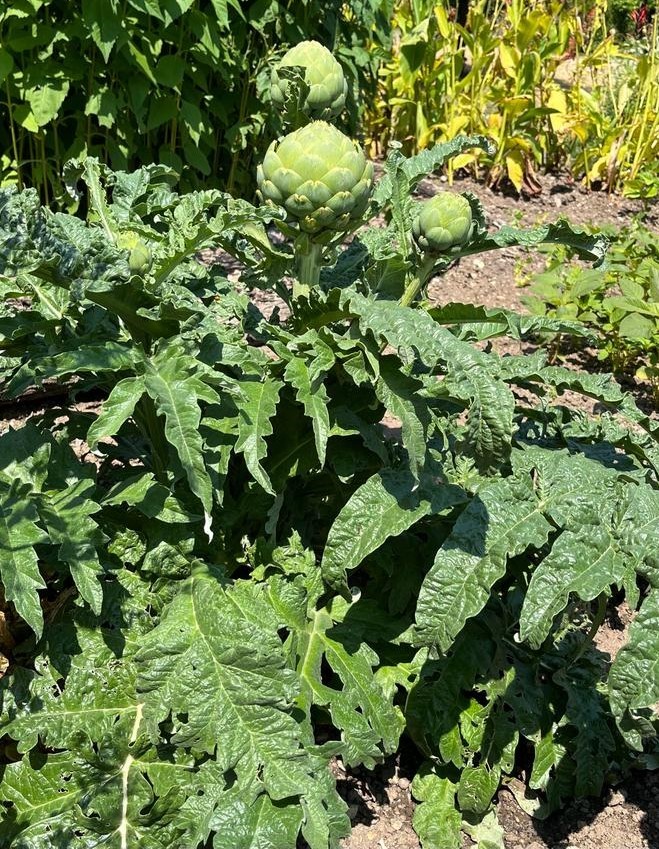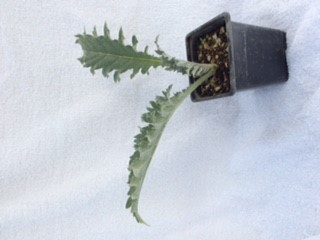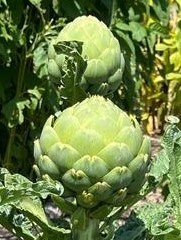Space plants 90cm apart.
Globe artichokes are perennials - dying down in the winter before shooting up again each spring. Each year the clump of artichokes will get bigger. Divide the clump every four or five years in spring and replant the two halves. This rejuvenates them, as well as multiplying them up.
Globe artichokes are very easy plants to grow and tend to look after themselves. Growing several varieties spreads the harvest out.

Artichokes like a warm, sunny, sheltered spot which is well drained.
Soil Preparation
Prepare the soil to give an even depth of fine particles and remove any stones. Mix some general-purpose fertiliser into the soil.
Planting
Globe artichokes will be ready to plant out when they have five true leaves. Wait until the weather has warmed up and there is no chance of frost.
A week before planting out, harden the plants off by placing them outside during the day and bringing them in at night. This will get them acclimatised to the conditions outdoors.
Water the pot containing the globe artichoke plant the night before planting out so that it is well soaked.

Remove the plant from the pot by gently holding the leaves with finger and thumb whilst spreading other fingers over the soil in the pot, tipping the pot upside down and gently shaking the plant out.
Make a hole in the soil the size of the root ball. Place the root ball into the planting hole and carefully push the soil around the roots to fill in the hole. Firm the plant in so that the roots are in contact with the soil.
Water the newly planted artichoke so that the soil is soaked. Use a can with a rose which will give a soft spray and not damage the leaves. Keep the soil damp until the plant is established, but not waterlogged.
Once established globe artichokes will not need watering until the flower heads appear. Water helps the buds swell.
Protect the young plant from frosts by covering it over at night if frost is forecast.
Weed around the young artichoke plant regularly so it does not have any competition for water, nutrients, or sunlight. It is easy to pull weeds out by hand as they appear.
Mulch
Every spring apply a thick layer of mulch around the plants. Use garden compost, leaf mould or straw. This will conserve moisture, feed the plants and keep down weeds.
Flowers
Flowers of globe artichokes are like thistle flowers, large and purple. Bees love the nectar and pollen the flowers produce.
In the first year, cut the flower stems out as soon as they appear. This allows the plant to put all its energy into getting established; but it means that there is nothing to harvest in the first year.
In following years, the flower buds are harvested for eating. Cut the buds off as they fill out, making sure you do it before they burst into flower.

When the whole flower bud is about golf ball size, use secateurs to cut it out, leaving a good length of stalk on the bud. Cut them just above a leaf joint. Take the main bud first, then harvest those on side shoots as they get bigger. The buds need to be tightly closed, so check them every day to make sure the buds don’t open and turn into flowers.
If you like to see the purple flowers, grow a second globe artichoke just for that purpose, to give the garden colour and help the insects.
Winter Care
In the autumn remove any broken or damaged leaves and cut out the flower stems.
Cover the clumps with garden compost or straw to keep the frost out. In the first year the plants will still be a little delicate so cover them with fleece in hard weather.
Mon - Fri 8:00am - 5:00pm
Sat & Sun 9:00am - 5:00pm
Any questions? Email us or give us a call on 01904 400092.